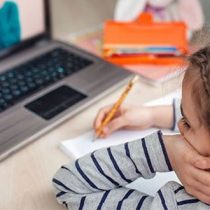
The return to face-to-face in schools was one of our country’s great longings for the start of the school year, as authority had to move towards a transition process due to current health conditions, ongoing vaccination campaign and differences with the College of Teachers, municipalities and school communities. Remote or remote classes, in this scenario, will continue to be transcendental at least during the first half of this 2021.
This modality, implemented as an emergency to continue school activity, meant various difficulties for 68% of the child population, according to report No. 9 on the state of children of Life in Pandemic, longitudinal study of the University of Chile on the impact of the health crisis on the population.
This was stated by parents and caregivers of children, who stated that 70% of children and 66% of girls experienced difficulties related to willingness to do homework and connect to classes, concentration, motivation and participation in online classes.
Little learning
On this point, Fabián Duarte, academic of the Faculty of Economics and Business of the U. of Chile, director of the Millennium Core in Social Development (DESOC) and one of the researchers of Life in Pandemic, emphasizes that “the fact that more than two-thirds of students present various difficulties when studying remotely, indicates that the methodology has not been totally successful. In addition, the takers believe that their pupils and pupils have not learned in this period.”
Research, supported by Unesco, further found that this gender gap at the children’s level is increasing for municipal schools, where 60% of girls and 73% of children would struggle with remote education. On the other hand, he identified that students would experience greater difficulties as parents and caregivers are younger (75% in the 20-34 age group; 65% in the 35-44 group and 63% in over-45s.
Another finding is that 56% say that children under their care have gained weight since the onset of the health crisis, while 40% kept it and only 4% would have dropped. Respondents and surveys further note that boys would have gained more weight than girls (60% boys and 52% girls). At the age level, smaller and smaller children would have gained less weight than the older child segment in this report: 50% in the range 5 to 7 years and 60% between 8 and 12 years.
Psychological well-being
One of the aspects delved into in this report relates to the mood and evolution of psychological discomfort during the first nine months of the pandemic. On the latter point, the study suggests that 35% of parents and caregivers notice a deterioration in psychological well-being in the child population, 54% indicate that it has not changed and 11% argue that it has risen.
The survey, conducted between 26 November and 12 December 2020, recorded a gender-associated difference for adults at this point, as women report more often a deterioration in child psychological well-being than men. 70% of men versus 59% of women report that boys and girls are much better off or staying the same, while 30% of men and 41% of women say they have worsened. On the other hand, children develop better as their parents or caregivers are older.
Irma Palma, academic at the Faculty of Social Sciences of the U. of Chile and principal researcher of this research, highlights the gender differences of adults in how they see minors.
“Women report children more harmed in their psychological well-being than men. They observe them from their own harm, which is much greater than that of men, and from their care work, which is much higher. Men attend much less than women and declare greater autonomy for children in the study. Our hypothesis is that seeing greater autonomy allows them to justify not doing attendance, and seeing less psychological harm in children allows them to do less emotional work. In November, 41% of women and 23% of men attended children every day of the week in their study,” she explains.
Regarding the mood of the child population at the time of the application of the survey, according to the report of parents and caregivers, 58% declare that minors are animated or very lively, 26% neither encouraged nor discouraged and 16% discouraged or very discouraged. Younger children would have a better mood. While in the range of 5 to 7 years the animated-very animated/discouraged-very discouraged response is 65% / 15%, in the range 10 to 12 years is 50% / 19%.
Socio-economic differences, meanwhile, reflect that children’s mood is better in higher-income than lower-income sectors. 64% of the first group declares that the minors under their care are lively or very lively, a figure that reaches 53% among the less affluent. At the territorial level, meanwhile, the mood in children in the Metropolitan Region is better in higher-income communes than in lower-income ones. In the former, the animated-very lively index is 65% and the discouraged-very discouraged rate is 12%, while in the latter it is 56% and 16%, respectively.
More connected
Another aspect evaluated by this report relates to the connection of minors to networks to communicate with friends. In this area, the study revealed that the children using these technologies to communicate with friends for one or more hours would have increased by 12%. The results in this topic indicate that the use of networks for contact with friends is lower in lower-level minors and higher in higher-income sectors and paid private schools.
On the other hand, 49% of first-school children would have had contact with schoolmates during this period. Overall, age analysis showed that contact grows as age increases, a trend that exhibits a break in the female segment aged 10 to 12, where girls would be less communicated than boys (50% and 60%, respectively) and that the girls segment between 8 and 9 years (down from 55% to 50%).
The biggest difference at this point occurs according to socioeconomic group and type of school. Communication with peers between poorer children, according to the women’s report reaches 29% in municipal schools and 31% in the lowest-income group. “That is, seven out of ten children lost the generational bond, the one that is done in the school day-to-day life at the school. By contrast, the richest children, according to the men’s report, reach 74% in paid private schools and 60% in the lowest-income group,” says Irma Palma.
Finally, death is in the intergenerational conversation during the crisis in families. Faced with the reality of getting sick and dying, as the main fact of the pandemic, 66% of parents or caregivers have discussed this issue with minors under their responsibility in this period. The results indicate that younger adults do so to a much lesser extent than older adults, a phenomenon that is mainly due to the former living with younger children.





